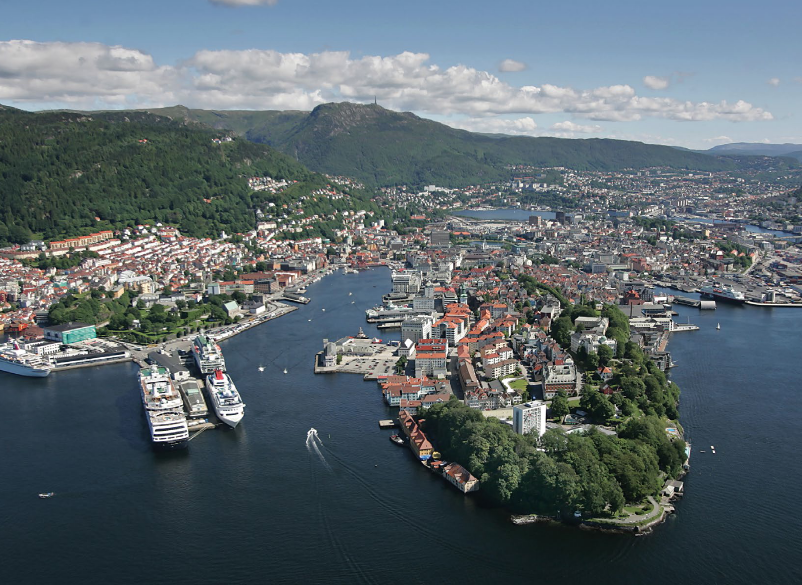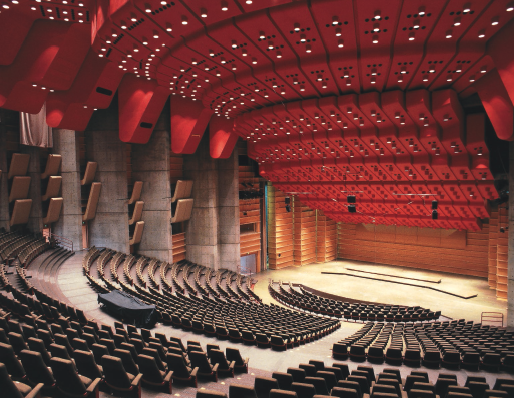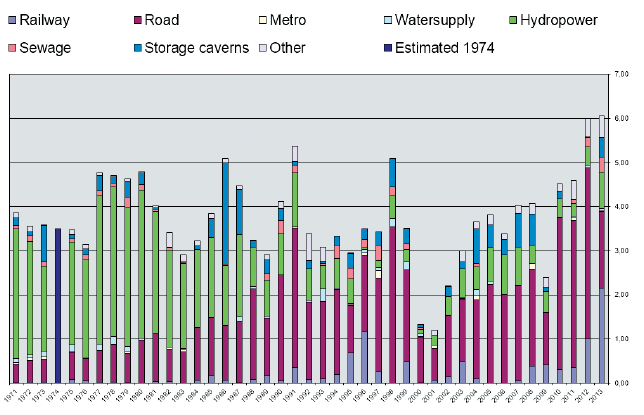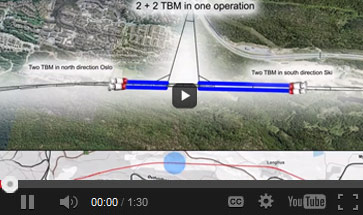Norway launches bid to host WTC2017
2 Apr 2014
TunnelTalk reporting
- The Tunnelling Society of Norway (NFF) begins its campaign for the right to host WTC2017 in the coastal city of Bergen.
-

Bergen in Norway boasts a beautiful location
- Part of the business of Iguassu Falls in Brazil will be to vote for a host city and venue in three years time – Dubrovnik in Croatia will host WTC2015 and San Francisco, USA, WTC2016 – and NFF has already been busy preparing its campaign.
- A block booking of the proposed venue – the Edvard Grieg Hall, home of the Bergen Philharmonic Orchestra – has already been made for the week 9-16 June 2017, with hotels in the beautiful coastal city put on alert to host delegates of the event. Provisional technical tours of some of the country’s growing number of mega projects are also suggested in a brochure in support of the bid that is being prepared for WTC2014 in Brazil next month.
- The hall that would host the General Assembly and Open Session has a capacity of 1,500, and an indoor exhibition space centred in a single hall with no corridor booths can cater for 120 stands of 3m x 3m. Organisers say extra exhibition space can be made available outside if needed.
-

Edvard Grieg Hall conference venue
- Under the theme of the conference, “Surface Problems – Underground Solutions”, NFF says the focus will be on the wide scope and the variety of applications of underground utilisation, pointing to Norway’s long tradition of using the underground for a wide range of applications and its proud heritage of providing breakthrough solutions and technologies that in many cases constitute the state-of-the-art today.
- Norway, given its challenging geography, has always been a nation with a strong tunneling pedigree, and with a number of remarkable projects only just in construction or at an advanced stage of planning and procurement, it is well placed to secure the votes it needs.
-

Excavation volumes by sector in millions of m3 (1971-2013)
- Since 1971 NFF has prepared annual statistics demonstrating the key role that the development of underground infrastructure plays in the country. Over the last five years an average underground space volume of 4-6 million m3/year has been excavated for an equivalent annual tunnelling distance of 60-100km at a cross section of 60m2.
- Until the 1980s hydropower dominated, later it became road tunnelling, and more recently the railway sector has increased its share to such an extent that last year (2013) it became the number one sector of the tunnel construction industry in Norway (Fig 1). One of the key drivers going forward is expected to be long TBM-driven tunnels connecting offshore oilfields with the mainland, but technological advances in this field will be required for this market sector to develop. Another area in which Norway leads technological development is the relatively new application of floating submerged tunnels where depth and steep inclination precludes existing TBM and fixed immersed tunnelling technology.
- Last year marked the return of the TBM methodology to Norway after an absence of more than 20 years, with a refurbished 7.23m diameter Robbins machine selected to excavate 12km of a new 19km of parallel headrace tunnel needed to rebuild and increase the output of the existing Røssåga hydropower station.
- Meanwhile, mechanised tunnelling received another boost in 2013 with the decision to utilise TBM technology for excavation of the running tunnels of Norway’s largest underground infrastructure project, the high speed Follo Line between Oslo and Ski.
-
Key projects include:
- The record-breaking undersea US$1 billion Ryfast twin tube road tunnel project, which comprises three interlinking tunnels and is already under construction, will become the world’s longest underwater road connection (23km) when it is completed. Project scope also includes a 3.9km tunnel under the city of Stavanger for continuous connection.
- The US$2.2 billion Rogfast tunnel, at 27km in length, will take over from Ryfast as the world’s longest subsea road tunnel when it is completed in 2022-23. The project involves a twin tube connection between Arsvågen and Harestad, likely to be excavated by conventional means, though with the possibility of TBMs with a diameter of 11-12m not ruled out. Current designs show a total excavation of 60km, including the long ramps that will be necessary to connect the island of Kvitsøy to the main tunnel. The project is due to go into detailed final engineering design in the coming weeks and months.
- The 4.1km submerged floating tunnel that will form the Coastal Highway (E39) Sognefjord Crossing is expected to enter construction during the period 2018-23. It features two twin tube subsea road tunnels, and owing to the great depth of the fjord (1,250m) will not have any fixed foundations on the sea floor.
- The high altitude 5.75km Filefjell Tunnel is expected to go into construction later this year.
- Delivering the Follo Line Project which will double rail capacity between Oslo and Ski and is designed for speeds of up to 250km/hr, will involve construction of the country’s longest railway tunnel (19km), and the first to be excavated by TBM. Construction is expected to begin later this year with completion scheduled for 2021.
- Members of Norway’s Tunnelling Society will be well represented at WTC2014 in Iguassu Falls, Brazil, next month, and will be lobbying strongly for the votes they will need to bring the industry’s flagship event to Bergen in 2017.
-
Prequalifers confirmed for Oslo-Ski Follo Line - TunnelTalk, October 2013
Tendering for world’s longest subsea road tunnel - TunnelTalk, September 2013
Hydro brings TBMs back to Norway - TunnelTalk, September 2013
First award on record-breaking Ryfast project - TunnelTalk, May 2013
Subsea tunnels for oilfield development - TunnelTalk, November 2013
Optimum advance for long distance TBM drives - TunnelTalk, January 2014
Links across the waters - TunnelTalk, January 2010
|
|
|
|
|
Add your comment
- Thank you for taking the time to share your thoughts and comments. You share in the wider tunnelling community, so please keep your comments smart and civil. Don't attack other readers personally, and keep your language professional.



